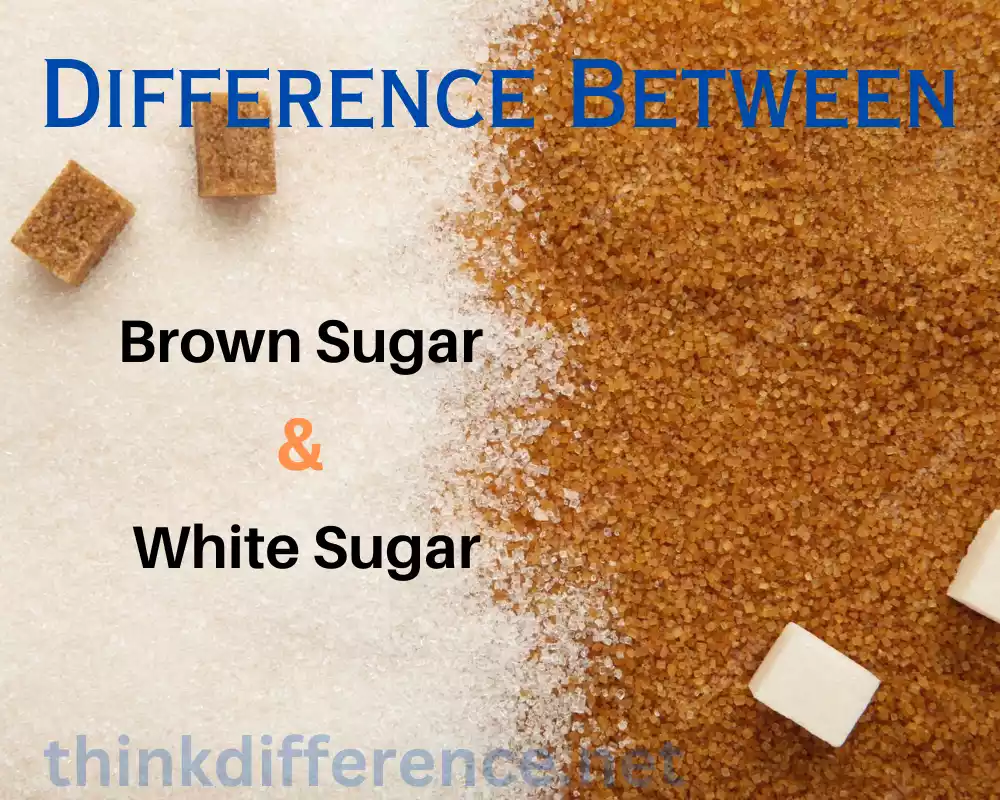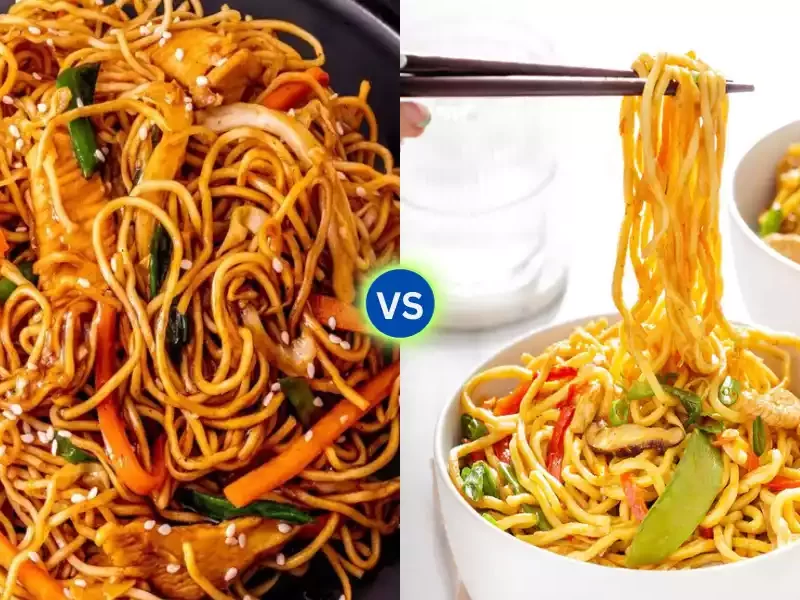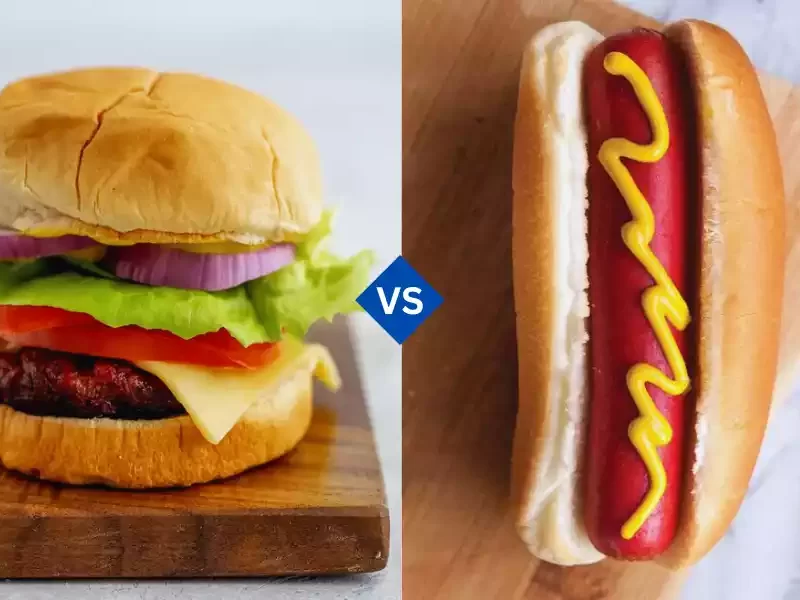Brown Sugar and White Sugar each differ considerably in composition, flavor profile, scent profile and even texture. Their nutritional profiles and blood sugar impact vary considerably – understanding these distinctions will enable you to make informed choices when selecting recipes as well as reduce consumption of both types of sugars.
As part of this outline of content we will investigate the manufacturing processes, composition and flavor scent of color of white and brown sugar production. Its culinary applications, nutritional differences between them and health implications compared with each. Eventually you will gain an insight into their differences so as to make informed choices when cooking or purchasing food products and recipes.
What is Brown Sugar?
Brown sugar stands out as an exceptional form of sugar due to its distinctive golden to dark brown hue and soft texture, used extensively in both baking and culinary applications to add both depth of flavor and moisture to recipes. Brown sugar production involves different processes than white sugar production which gives this form its unique characteristics.
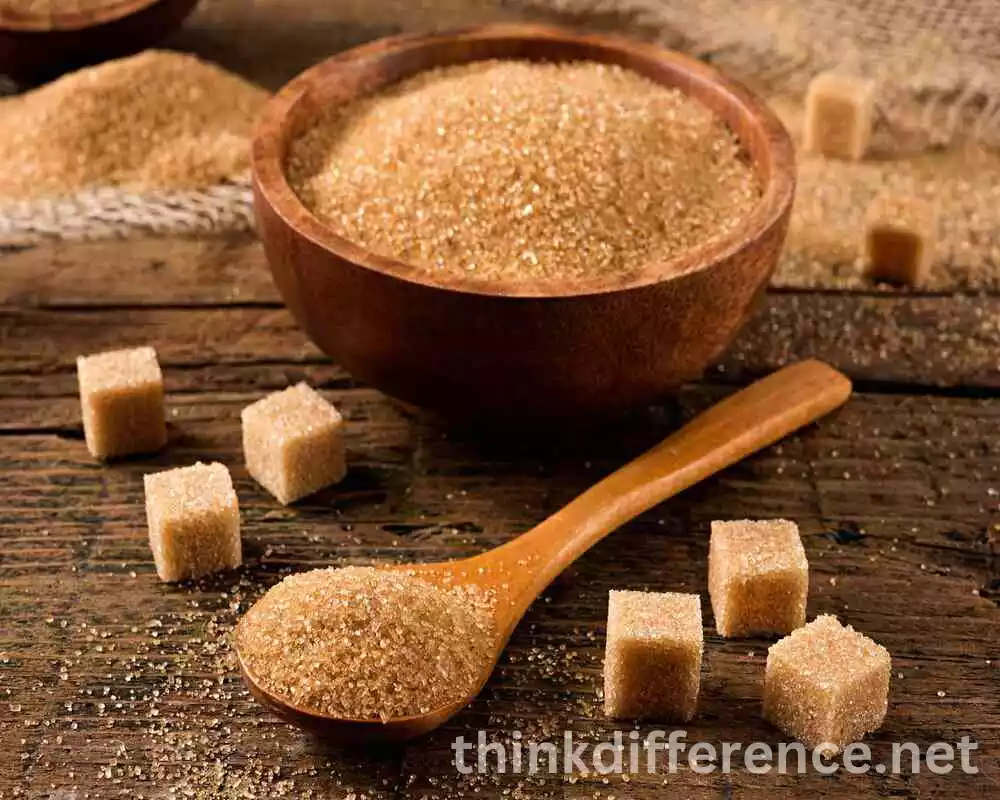
Brown sugar is produced by extracting sugar cane liquid and passing it through an evaporation and crystallization process, with additional stages for crystallization and molasses addition – an end product from refining sugar that adds syrupy goodness as well as trace minerals – into production process. How much molasses added determines darkness and intensity.
Brown sugar typically contains 3 to 6% molasses depending on its kind and variety, contributing significantly to its distinct taste and aroma, including caramel notes that add richness, as well as providing moisture needed by sugar crystals for soft texture that differs significantly from white sugar.
Brown sugar comes in both dark and light varieties, providing culinary professionals with plenty of culinary possibilities. Light brown sugar features an effervescent taste and lighter hue while dark brown sugar has more of a molasses-like taste with darker coloring allowing for various culinary applications. These different sugar varieties allow for plenty of options when crafting dishes!
Brown sugar’s unique properties make it the go-to choice when baking cookies, muffins and cakes, in addition to other sweets. Its delectable flavor and soft texture makes it indispensable when creating glazes, sauces marinades and sauces.
The Composition of Brown Sugar
Brown sugar differs from white sugar due to the presence of Molasses.
Below are its primary components:
- Sucrose: Brown sugar and white sugar both contain sucrose as their main component. It is a disaccharide made up of glucose and fructose molecules.
- Molasses: Molasses is the key factor that distinguishes brown sugar from white sugar. It is a thick, syrupy byproduct of the sugar refining process. Molasses contains various sugars, vitamins, minerals, and antioxidants. The amount of molasses added to brown sugar varies, leading to different shades and flavors. It contributes to the distinct caramel-like flavor, aroma, and moisture content of brown sugar.
- Impurities and Trace Minerals: Brown sugar may contain small amounts of impurities and trace minerals that are present in molasses. Brown sugar contains potassium, calcium and magnesium as well as smaller amounts of iron, calcium and others that don’t offer substantial health benefits. Their effects might not be noticeable enough.
Remember that sugar composition differs depending on its brand or kind. Light brown sugar typically contains lower levels of molasses than its dark counterpart and has stronger flavors and deeper colors as a result of more molasses content in dark brown varieties.
Brown sugar differs from its white counterpart in that its refinement process retains some impurities and molasses that give its unique flavour and properties. By keeping some impurities and molasses intact, its unique nature and properties remain.
Production Process of Brown Sugar
Producing brown sugar involves several distinct steps that differ from making white sugar, as detailed here:
- Extraction of Sugar Cane Juice: Brown sugar is typically made from sugar cane, although some variations may use sugar beets. The first step involves extracting the juice from the sugar cane stalks. This juice contains sugar, water, and other plant components.
- Evaporation and Crystallization: The extracted sugar cane juice is then heated to evaporate the water content. This process thickens the juice, leaving behind a concentrated syrup containing sugar molecules. The syrup is further cooled to promote the formation of sugar crystals.
- Molasses Addition: Unlike white sugar production, brown sugar production involves the addition of molasses. Molasses is a thick, dark syrup that is a byproduct of the sugar refining process. It contains residual sugars, minerals, and other compounds. The amount of molasses added to the sugar crystals determines the darkness and flavor intensity of the brown sugar. The molasses is thoroughly mixed with the sugar crystals, coating them and imparting its characteristic flavor and moisture.
- Drying and Packaging: After the molasses is incorporated into the sugar crystals, the mixture is dried to remove excess moisture. The drying process ensures that the brown sugar has the desired texture and is free-flowing. Once dried, the brown sugar is typically sifted or sieved to remove any lumps or impurities. It is then packaged and ready for distribution and consumption.
The production process may vary slightly depending on the specific manufacturer or region, but the fundamental steps remain the same. The addition of molasses during the production process is what gives brown sugar its distinctive color, flavor, and moist texture compared to white sugar.
What is White Sugar?
White sugar (also called table sugar) is a refined and widely utilized form of sugar that has become the standard. A crystallized substance with soft textures and white hue, hence its popular moniker of “white sugar.” White sugar has long been utilized by food and beverage industries as well as households alike and its use remains ubiquitous today.
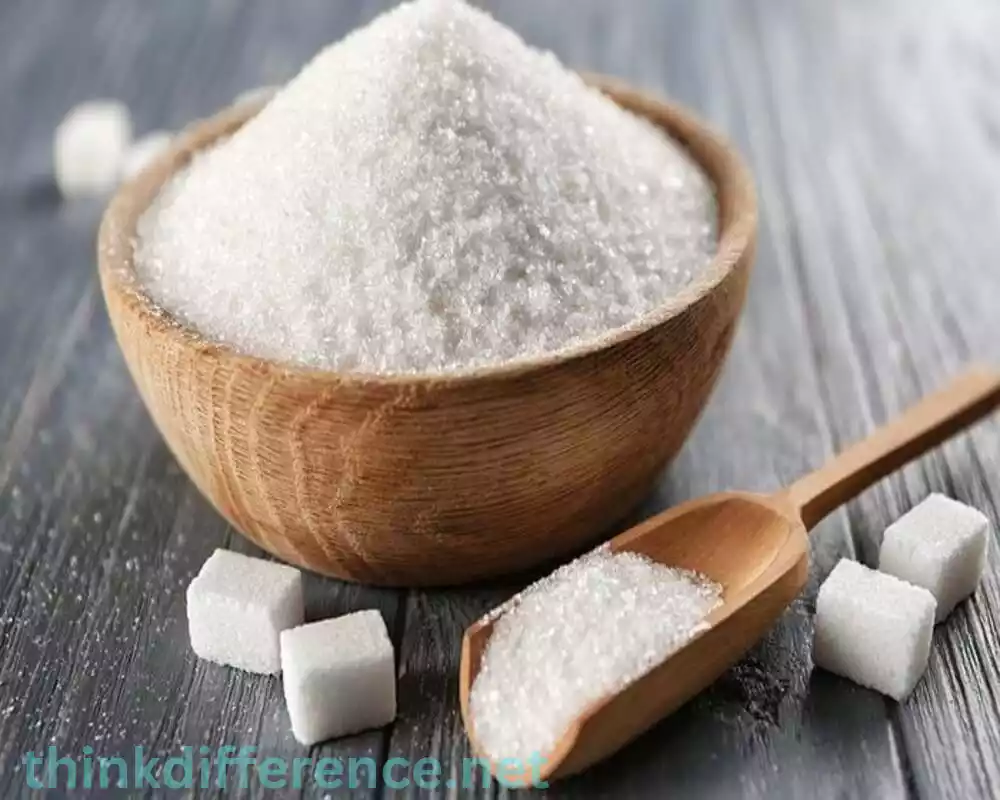
White sugar is typically created from sugar beets or sugarcane that have undergone refining to produce pure sucrose, an irreducibly simple disaccharide composed of fructose and glucose molecules that is the primary constituent of white sugar.
White sugar production involves various steps, from extraction of raw sugar through purification, centrifugation, crystallization and packaging. All these processes aim at eliminating impurities like molasses or non-sugar ingredients which lead to pure refined sucrose crystals being created.
White sugar is famed for its ease of dissolution in liquids. With no distinct aroma or flavor to speak of, its sweet neutral taste makes it the go-to sweetener choice across a range of cooking applications – baking or cooking as well as beverages like tea and coffee! Its wide use also extends beyond sweetening beverages alone to include adding an element of crunchiness when serving dessert.
Sugar white is an integral component in food industry, being utilized to produce confectioneries, processed foods desserts, beverages and desserts ranging from confectioneries and processed meals through beverages to confections and pastries. Sugar provides sweetness as well as texture to their products while bulking them out too!
Sugar should be consumed with caution as excess consumption can result in serious health concerns such as dental decay and weight gain, leading to chronic illness risk and increasing dental caries risk. A balanced and varied diet that takes account of total sugar intake would provide optimal outcomes.
The Composition of White Sugar
White sugar contains one major component – sucrose.
Here’s a breakdown of what comprises white sugar:
- Sucrose: Sucrose, composed of fructose and glucose molecules, makes up more than 99.9 percent of white sugar’s composition and can be found both in sugar cane and beet roots–two primary sources for white sugar production.
- Water: White sugar contains a small amount of water, typically less than 0.5%. The water content varies depending on factors such as storage conditions and manufacturing processes.
- Trace Impurities: While white sugar goes through a refining process to remove impurities, trace amounts of non-sugar compounds may still be present. These impurities include minerals, proteins, and organic residues. Their concentrations are negligible and do not significantly impact the nutritional value of white sugar.
Consider that white sugar has undergone intense refining processes to remove its color, molasses and any impurities – thus contributing to its distinctive white hue and neutral flavor. Brown sugar features high levels of molasses content which distinguish it from its more refined cousin, giving its distinct brown hue and brown flavor profile.
White sugar, composed largely of sucrose, offers both sweetness and energy for sustained energy needs. Although eating excessive quantities could increase risk factors associated with dental decay, obesity, and chronic illness in larger quantities.
Production Process of White Sugar
Producing white sugar involves several stages of refining and purification that aim to remove impurities such as molasses and impurities in order to produce pure crystals of sucrose, and eventually crystals with unadulterated sucrose crystals.
Here is an outline of this typical manufacturing process of white sugar:
- Extraction: The first step in white sugar production is the extraction of sugar cane or sugar beet juice. Sugar cane stalks or sugar beets are crushed or sliced to extract the juice, which contains sugar, water, and other plant components.
- Purification: The extracted juice undergoes a purification process to remove impurities. Process components include clarification, filtration and chemical addition. The juice is typically heated and treated with lime or other chemicals to help remove suspended solids and impurities.
- Concentration: The purified juice is then concentrated by evaporating excess water. This is usually achieved by heating the juice in multiple stages to progressively increase its sugar concentration.
- Crystallization: The concentrated juice is further cooled, and sugar crystals are initiated by adding “seed crystals” or fine white sugar particles. The mixture is carefully stirred or agitated to promote crystal growth. As the sugar crystals form, they grow in size.
- Centrifugation: Once the sugar crystals have reached the desired size, the mixture undergoes centrifugation. Centrifugal force helps separate sugar crystals from their liquid source – known as molasses. The molasses contains residual sugar, water, and other impurities.
- Drying: After centrifugation, the separated sugar crystals are washed with water to remove any remaining traces of molasses. The crystals are then dried to reduce moisture content. This step ensures the production of dry, free-flowing white sugar.
- Packaging: The final step is the packaging of the white sugar into appropriate containers or bags for distribution and consumption.
Keep in mind that production processes vary based on factors like manufacturing facility, sugar source (either cane sugar, beets sugar or even cane) and local practices. The purpose is to refine and purify sugar for producing pure white sucrose crystals.
Differences between Brown Sugar and White Sugar
White sugar and brown sugar differ substantially in many aspects, from flavor, composition, color, moisture content and food applications to main differences between them.
These are among the major distinctions between them:
- Composition: Brown sugar contains molasses, while white sugar does not. The molasses content gives brown sugar its distinct flavor and moist texture. White sugar consists primarily of pure sucrose.
- Flavor and Aroma: Brown sugar is famed for its caramel taste, with an extra rich edge thanks to Molasses content. It adds depth and complexity to recipes. White sugar has a neutral taste without any distinct flavor or aroma. It provides sweetness without altering the flavor profile of the dish significantly.
- Color: Brown sugar ranges in color from light to dark brown, depending on the amount of molasses added. The molasses gives it its characteristic brown hue. As its name implies, sugar white is so-called due to being refined to remove impurities such as molasses.
- Moisture Content: Brown sugar has a slightly higher moisture content compared to white sugar. The presence of molasses in brown sugar adds moisture, resulting in a softer and more moist texture. White sugar is dry and free-flowing.
- Culinary Uses: Brown sugar is commonly used in baking and cooking, particularly in recipes where its distinct flavor and moistness are desired. It is popular for making cookies, cakes, muffins, and sauces. White sugar can serve a multitude of uses when it comes to culinary applications and recipes involving sweeteners; from baking beverages and confectionary, to general use in various food recipes.
- Texture: Brown sugar has a slightly coarser texture compared to white sugar due to its higher moisture content. White sugar has a fine, granulated texture.
- Nutritional Differences: Brown sugar and white sugar have similar caloric content, but brown sugar contains slightly more minerals due to the presence of molasses. Nutritionally speaking neither type of sugar presents significant differences; both provide essential nutrition.
Remind yourself that both brown sugar and white sugar should only be eaten in moderation as too much could have serious adverse health ramifications.
Culinary Uses of Brown Sugar and White Sugar
White and brown sugar both offer many culinary uses and recipes in which these sweeteners are frequently employed, including:
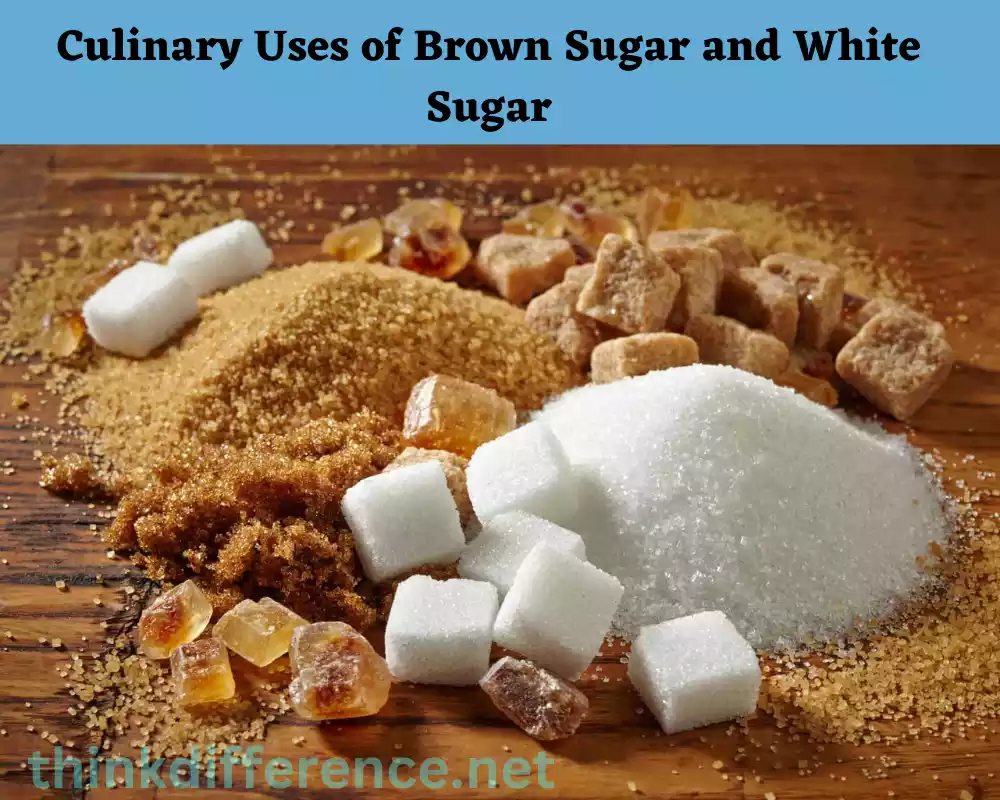
Brown Sugar:
- Baking: Brown Sugar Brown sugar is used in baking to add moisture, richness and caramel-like notes that give baked goods moisture, richness and an irresistibly decadent caramel-esque taste. Often it can be seen being utilized for cakes, cookies, brownies muffins as well as sweetbreads.
- Sauces and glazes: Brown sugar is an indispensable component in meat sauces such as barbecue sauce or the teriyaki glaze, imparting both sweet and savory notes for added depth, plus producing the illusion of an alluring sticky surface.
- Caramel and Butterscotch: Brown sugar is essential in creating delectable butterscotch and caramel sauces for sweets, candies and desserts, while adding additional depth and sweetness with the help of molasses as an ingredient.
- Sweetening Beverages: Brown sugar can add an exquisite caramel flavour to beverages such as tea, coffee and hot chocolate.
White Sugar:
- Baking: White sugar is frequently employed in baking as both a sweetener and structure builder, commonly found in cookies, cakes, bread, pastries and many other baked products.
- Beverages: White sugar can quickly dissolve in liquids to add sweet flavour, perfect for beverages such as tea, coffee and lemonade – as well as iced tea and fruit juices – adding the perfect finishing touch of sweetness.
- Preservation: White sugar can help preserve fruits, jams and jellies made with fruit as well as be an ingredient of sweeteners. It not only assists with preservation but can be an ingredient used in these sweeteners too!
- Desserts and Confections: White Sugar is an integral component in creating many delectable confectionery desserts and confections such as fudges, candies and even meringues, frostings and frostings that add sweetness and texture. It makes these treats irresistibly tempting!
White and brown sugar can often be substituted in recipes to suit desired taste and texture, although due to brown sugar’s unique flavour and moisture content it might not always work out that well as an exact replacement compared to its white sugar equivalent. Therefore, always refer to specific recipe guidelines when substituting products accordingly for optimal outcomes.
Health Implications
Consumption of brown and white sugar in large quantities poses health risks that should not be neglected.
Here are the major considerations associated with excessive sugar intake:
- Dental Health: Consuming too much sugar – whether white, brown, or other- could contribute to dental decay and cavities, since bacteria living in your mouth feed off sugar to produce acids which damage enamel on teeth. Therefore it’s crucial that good oral hygiene practices such as cutting back on consumption of sweets be observed to maintain good dental health and keep teeth at their best condition.
- Blood Sugar and Insulin Response: Sugar Intake and Insulin Response To avoid this situation, limit sugar consumption as much as possible and search out carbs with low glycemic index ratings when selecting foods to consume. A sugar high can trigger blood glucose spikes which will put strain on your insulin system and put at greater risk of type 2 diabetes and resistance over time. It is advised to consume as few refined sweeteners such as white sugar as possible. This will prevent spikes and further strain to your system which might eventually result in type 2 diabetes or resistance development.
- Controlling Weight: Consumption of excessive sugary products that contain plenty of calories but lack nutrients may contribute to obesity and weight gain, particularly drinks and foods with added sugars that increase caloric consumption. An informed diet which limits added sugars while emphasizing food with plenty of nutritional content is critical in maintaining an ideal bodyweight for any individual.
- Nutrient Deficiency: Sugar consumption could rob your diet of essential vitamins, minerals and fiber sources; excessive consumption could result in an unbalanced diet due to sugar deficiency.
- Chronic Diseases: Excess sugar consumption when combined with lack of exercise and poor eating habits has been linked with an increased likelihood of chronic diseases like type 2 diabetes, obesity, cardiovascular disease as well as certain cancer types. An appropriate balanced diet free from added sugars should be recommended to maintain overall good health and prevent diseases like these from emerging.
Keep in mind that moderate sugar intake in an informed diet is generally accepted by most. To maximize results from any healthy lifestyle changes you make to your diet, be mindful of overall sugar consumption. Incorporate nutritious options into every meal for best results; visit with healthcare specialists or registered dietitians who can give tailored advice about sugar consumption according to individual goals and needs.
Conclusion
Brown sugar and White sugar both offer their own unique set of advantages when used correctly in recipes, with brown’s added molasses adding delicious depth. White sugar’s versatility means it can be used in numerous applications, moderate usage should ensure a healthier lifestyle overall.

